9 out of 10 startups fail. Why? The most common reasons are a lack of budget and an ineffective team. So if you want your business to thrive, you should start by creating a minimum viable product. Validate an MVP to assess the market's interest in your idea and what you can do to achieve success. In this article, we will explain why a business needs to create an MVP and describe in more detail how to test a minimum viable product.
What You Should Know About MVP
An MVP (minimum viable product) is the initial version of your product designed to gauge the market's reaction to your business idea. The creation of MVP implies rapid development and relatively low implementation costs.
The term minimum viable product was first used in Lean Startup, which describes a methodology for rapid product building. Instead of spending years developing a complex application that could fail, the methodology suggests creating software that will assess users' demands.
Learn more about the features of MVP in Software Development.
MVP involves building a simple product but not a raw version. It is a complete software with simple functionality. When creating an MVP, it is worth focusing only on the basic features, without which the product cannot exist.
“MVP is a ready-made product with simple functions aimed at assessing the strengths and weaknesses of a business idea and finding effective ways for a startup's success.” - Andrey Onopriyenko, CTO at KeyUA
By creating a minimum viable product, a business gets the opportunity to determine effective ways for further development. Such giants as Twitter, Instagram, and Spotify started with the creation of an MVP.
Read everything you need to know about MVP Development Services for Startups.
Why You Should Test an MVP
There are two approaches to testing an MVP: when you check the quality of your product before it goes to market and when users try it to evaluate your business idea. Both of them are not mutually exclusive but, on the contrary, complement each other.
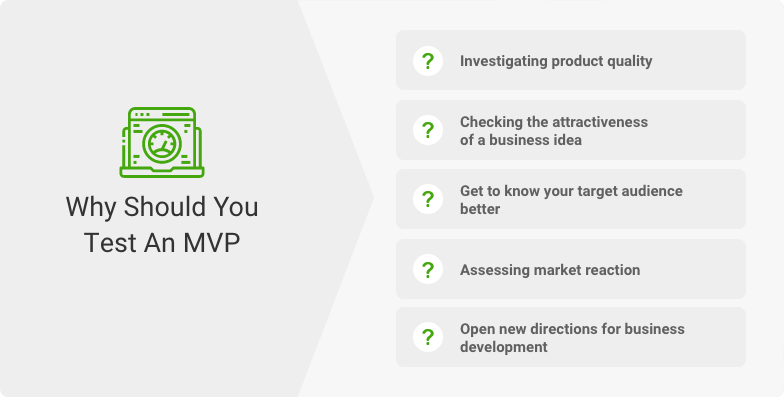
The first product testing takes place at the development stage. The team creates prototypes that are tested to choose the most suitable option. Prototyping consists of creating several variants of minimum viable product visualization. Among them, a small group that meets the parameters of the target audience or an internal team chooses the one that should best meet the needs of potential customers.
Investigate the difference between Prototypes and Proof of Concept in the article: MVP vs PoC vs Prototype: What's Best for Your Startup?.
The MVP approach assumes that the product will be developed quickly. Therefore, most of these projects use the Agile methodology. It presupposes effective interaction of the team, its flexibility to changes, and transparent cooperation with the customer.
When developing a product using Agile methodology, the entire software building process is divided into iterations. It’s as if you are creating a picture, puzzle by puzzle. After each iteration is over, testing must be performed to ensure that the application or website is working correctly. This is an internal process and is carried out by the quality assurance team.
Once the whole development is complete, the QA team thoroughly tests the entire product. They simulate the actions of real users to make sure that the software works without errors or crashes. MVP validation prior to market launch is critical. About 88% of apps are abandoned due to glitches. If you want to bring your minimum viable product closer to success, it must be tested before release to the market.
The next MVP testing technique occurs after its launch on the market. The goal of this process is to get the reaction of the target audience to the product. This will allow you to assess the attractiveness of a business idea and understand in which direction to move on.
Many successful modern companies started with the introduction of MVPs to the market. As a result of testing, they either confirmed the effectiveness of their business idea or completely changed the concept.
How to Test an MVP on the Market?
Building a minimum viable product is undoubtedly an essential process. But after you get the finished product, it's too early to stop. The next critical step is launching and evaluating the product. Testing aims to understand how a business idea meets the needs of the market and how you can further develop your product.
Steps to validating an MVP differ depending on its type and business needs. But we will consider the main approaches to assessing the demand for the product.
#1 Fundraising
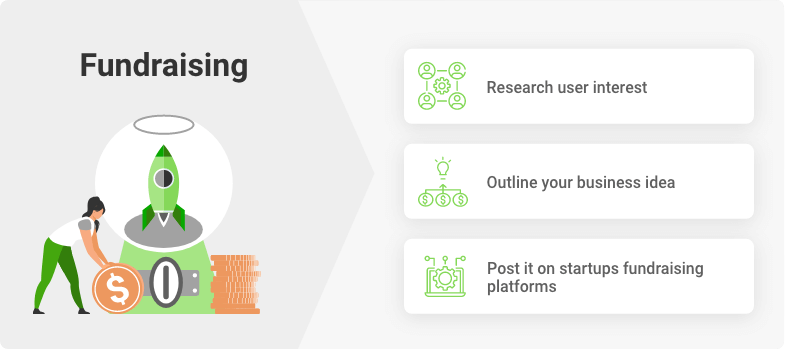
When asking how to test your MVP, one of the most common questions is how to attract potential users to its implementation. A popular way to assess how interesting a business idea is to users is to raise funds for its implementation. Moreover, in some cases, for this, it is not necessary to create a complex type of MVP (like a concierge or a Wizard of OZ). A landing page is enough.
Various platforms such as Kickstarter, Patreon, and IndieGoGo help startups raise money for their projects. This is an excellent prospect, as it allows you to evaluate not only how attractive the idea is but also to get investments to create a full-fledged product.
In order to raise funds, you have to create a campaign on the appropriate platform. After that, it is worth assessing the interest of users, namely the number of their donations.
For example, on Kickstarter, most campaigns make less than $10,000, which is a very low figure. However, some projects have received over $10M in donations. Namely, Pebble E-Paper Watch (raised $10,266,845), Pebble 2 (raised $12,779,843), and Pebble Time (raised $20,338,986).
But not all projects are so attractive. If you see minimal activity from the target audience and donations do not recoup the development cost, this suggests that you should refine your business idea.
#2 Interview Your Customers
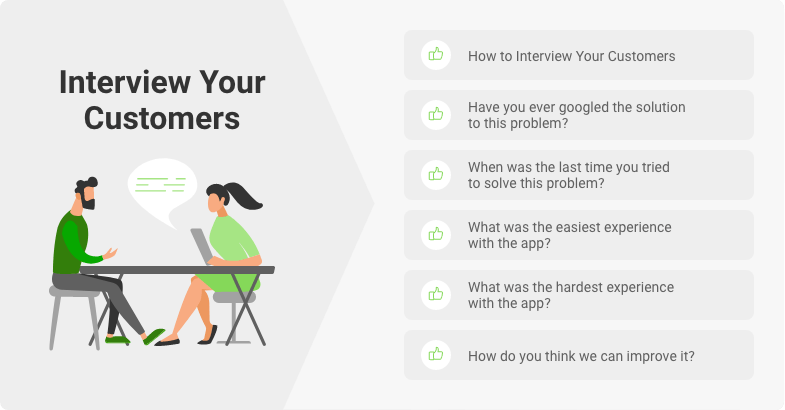
One of the best ways to test an MVP is to ask customers directly how they prefer to use your app. For example, Uber was originally intended to be a passenger-only app. In a customer survey, the creators found that adding driver-side functionality was a great opportunity to expand their business.
To test the MVP, you have to ask the users open-ended questions. Make a list of the problems that your product is designed to solve and ask customers how the MVP helped them with this. Pay attention to the detailed questions. It will allow you to get the most valuable feedback.
Also, ask users what additional features they would like to see in your product. The most popular answers are the direction to take when developing.
Don't ignore negative feedback. This is valuable information to help you turn your product's weaknesses into strengths.
“Interviewing is common in minimum viable product testing. Gather a small team from your target audience and let them try your application. Their feedback is the most valuable because it provides information from the point of view of a potential client, not the technical side.” - Andrey Onopriyenko, CTO at KeyUA
#3 Blogs
Blogging is a good way to interact with your target audience. It allows you to inform the public about your business idea, assess interest in it, and get feedback from potential clients.
There are 2 options here: create your own blog from scratch or use ready-made solutions. Building your own blog involves assessing whether you can drive organic SEO traffic to your website. As for ready-made solutions, Medium is pretty popular for blogging. Its advantage is that it already has a certain audience of readers, making it easier to find potential customers. For example, Eric Ries, the author of the Lean Startup concept, was blogging before he got an offer to write his famous book.
When testing a minimum viable product with this model, it is also worth paying attention to user activity. The higher it is, the more attractive your business idea seems.
#4 Ad Campaigns
Use advertising campaigns when researching the market and the response of the target audience. It will allow you to collect valuable analytics and assess how users interact with your business idea.
Advertising campaigns are fairly easy to launch using Google and Facebook tools. They also allow you to define the image of your target audience and show it to different groups of people with similar characteristics. For example, by gender, by location, preference, etc.
Analyzing clicks and the degree of user interaction with your brand will allow you to better position your MVP in the market. In general, modern platforms for advertising campaigns provide a wide range of convenient, reliable tools and services for assessing the attractiveness of your idea. It requires a relatively small investment, although it brings tangible results.
#5 Landing Pages
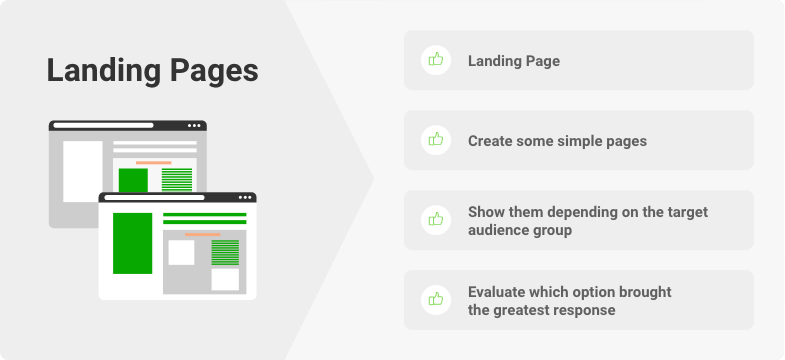
A landing page can be either the MVP itself or a way to promote it. This is one of the most effective ways to test a product and answer how users are interested in your proposal.
It allows you to take a closer look at your target audience. The landing page will help you find out exactly what your users are interested in.
For successful testing, you can create multiple landing pages. This way, you can collect not only user emails and determine the level of interest but also scale your business. Different types of landing pages with various designs and features can be created. It helps to segment your customers and attract the attention of a wider range of people. By the way, Buffer's MVP, which is now a popular social media records management app, was originally tested as a landing page.
#6 Hallway Testing
The idea of hallway testing is to check the usability of the product. The simpler and more intuitive an application is, the more users can use it. Plus, having an affordable sales funnel is what will bring solid profit. And such an effect cannot be achieved without good usability.
The essence of this minimum viable product testing is that you ask random people to check the interface of the application and give their opinion on how easy it is to use it. At the same time, you are not guided by any indicators of the target audience when choosing test subjects.
This type of testing allows you to identify the main problems that users face when interacting with the application. It is an excellent opportunity to find bottlenecks and make your product better.
#7 Testing With Social-Media
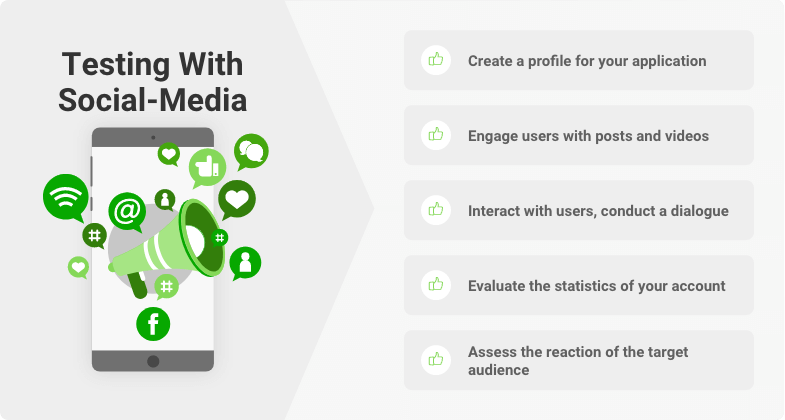
Social media allows you to collect valuable information from users quickly. For example, this can be done by surveys. Launching this type of MVP testing plan is pretty easy, especially if your product already has a social media account.
You should think carefully about the questions you will ask your target audience to get the most helpful feedback. Also, provide users with answer options to make it easy for them to leave a review. Some platforms offer to create a response box for customers to express their opinion.
Post information about your MVP, photos, and short videos on social media so that users can quickly understand how to deal with the product. Pay attention to the number of likes and reposts, the analysis of user engagement will demonstrate how relevant your business idea is.
Keep in touch with your users to learn about their experience with your product. Ask what options were useful to them and what difficulties they encountered when using the MVP.
Final Words
MVP testing strategies allow a business to determine the relevance of the idea and find alternative ways if it fails. This is why many startups begin with the building of a minimum viable product. This approach provides a quick and reliable assessment of market demand and requires a relatively small investment.
Have a great idea? Build an MVP! Let KeyUA take care of all stages of its implementation.
Contact Us







 Unit 1505 124 City Road, London, United Kingdom, EC1V 2NX
Unit 1505 124 City Road, London, United Kingdom, EC1V 2NX

Comments
Leave a comment